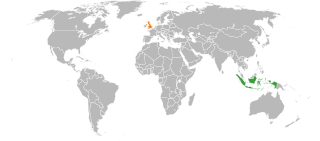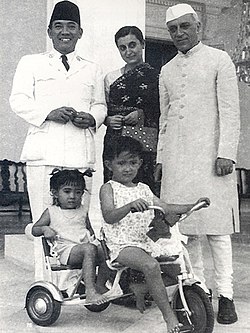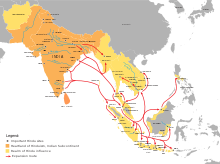
Java is one of the Greater Sunda Islands in Indonesia. It is bordered by the Indian Ocean to the south and the Java Sea to the north. With a population of 151.6 million people, Java is the world's most populous island, home to approximately 56% of the Indonesian population. Indonesia's capital city, Jakarta, is on Java's northwestern coast.

Hinduism in Southeast Asia had a profound impact on the region's cultural development and its history. As the Indic scripts were introduced from India, people of Southeast Asia entered the historical period by producing their earliest inscriptions around the 1st to 5th century CE. Today, Hindus in Southeast Asia are mainly Overseas Indians and Balinese. There are also Javanese and Balamon Cham minority in Cambodia and south central Vietnam who also practice Hinduism.

Prambanan is a 9th-century Hindu temple compound in the Special Region of Yogyakarta, in southern Java, Indonesia, dedicated to the Trimūrti, the expression of God as the Creator (Brahma), the Preserver (Vishnu) and the Destroyer (Shiva). The temple compound is located approximately 17 kilometres (11 mi) northeast of the city of Yogyakarta on the boundary between Central Java and Yogyakarta provinces.

Balinese Hinduism is the form of Hinduism practised by the majority of the population of Bali. This is particularly associated with the Balinese people residing on the island, and represents a distinct form of Hindu worship incorporating local animism, ancestor worship or Pitru Paksha, and reverence for Buddhist saints or Bodhisattava.

The culture of Indonesia has been shaped by long interaction between original indigenous customs and multiple foreign influences. Indonesia is centrally-located along ancient trading routes between the Far East, South Asia and the Middle East, resulting in many cultural practices being strongly influenced by a multitude of religions, including Buddhism, Christianity, Confucianism, Hinduism, and Islam, all strong in the major trading cities. The result is a complex cultural mixture, often different from the original indigenous cultures.

Hinduism has historically been a major religious and cultural influence in Java, Indonesia. Hinduism was the dominant religion in the region before the arrival of Islam. In recent years, it has also been enjoying something of a resurgence, particularly in the eastern part of the island.

Hinduism is the third-largest religion in Indonesia, based on civil registration data in 2022 from Ministry of Home Affairs, is practised by about 1.69% of the total population, and almost 87% of the population in Bali. Hinduism was the dominant religion in the country before the arrival of Islam and is one of the six official religions of Indonesia today. Hinduism came to Indonesia in the 1st-century through Indian traders, sailors, scholars and priests. A syncretic fusion of pre-existing Javanese folk religion, culture and Hindu ideas, that from the 6th-century also synthesized Buddhist ideas as well, evolved as the Indonesian version of Hinduism. These ideas continued to develop during the Srivijaya and Majapahit empires. About 1400 CE, these kingdoms were introduced to Islam from coast-based Muslim traders, and thereafter Hinduism, which was previously the dominant religion in the region, mostly vanished from many of the islands of Indonesia.

Greater India, also known as the Indian cultural sphere, or the Indic world, is an area composed of many countries and regions in South, East Asia and Southeast Asia that were historically influenced by Indian culture, which itself formed from the various distinct indigenous cultures of these regions. The term Greater India, as a reference to the Indian cultural sphere, was popularised by a network of Bengali scholars in the 1920s. It is an umbrella term encompassing the Indian subcontinent and surrounding countries, which are culturally linked through a diverse cultural cline. These countries have been transformed to varying degrees by the acceptance and introduction of cultural and institutional elements from each other. Since around 500 BCE, Asia's expanding land and maritime trade had resulted in prolonged socio-economic and cultural stimulation and diffusion of Buddhist and Hindu beliefs into the region's cosmology, in particular in Southeast Asia and Sri Lanka. In Central Asia, the transmission of ideas was predominantly of a religious nature.

The Mataram Kingdom ; also known as Medang Kingdom was a Javanese Hindu–Buddhist kingdom that flourished between the 8th and 11th centuries. It was based in Central Java, and later in East Java. Established by King Sanjaya, the kingdom was ruled by the Shailendra dynasty and Ishana dynasty.
This is an introduction to some of the books and novels written about Southeast Asia.

A candi is a Hindu or Buddhist temple in Indonesia, mostly built during the Zaman Hindu-Buddha or "Hindu-Buddhist period" between circa the 4th and 15th centuries.

The National Museum of Indonesia is an archeological, historical, ethnological, and geographical museum located in Jalan Medan Merdeka Barat, Central Jakarta, right on the west side of Merdeka Square. Popularly known as the Elephant Museum after the elephant statue in its forecourt, its broad collections cover all of Indonesia's territory and almost all of its history. The museum has endeavoured to preserve Indonesia's heritage for two centuries.

Trail of Civilizations was the motto of a symposium, initially held in August 2006 in Indonesia under the auspices of the governor of Central Java and the Indonesian Ministry of Culture and Tourism. Climax of the event was a ballet performance in front of the temple of Borobudur.

India–Thailand relations, also called Indian-Thai relations or Indo-Thai relations, are the bilateral relations between India and Thailand. Relations were established in 1947, soon after India gained independence. Priests have provided a cultural link between the two countries since 1500 BCE. India shares a long sea border with Thailand as India's Andaman and Nicobar Islands share a maritime border with Thailand along the Andaman Sea. Since 2001, both countries have witnessed growing warmth, increasing economic and commercial links, exchange of high-level visits, and the signing of various agreements leading to a further intensification of relations. Thailand and India are cooperating in various multilateral fora like India's dialogue partnership with ASEAN, the ASEAN Regional Forum (ARF), and the East Asia Summit, the sub-regional grouping BIMSTEC involving Bangladesh, India, Sri Lanka, Thailand, Myanmar, Nepal and Bhutan, and trilateral transport linkages with Thailand, Myanmar and India. India is a member of the Asia Cooperation Dialogue (ACD) initiated by Thailand in 2002 and of the Mekong–Ganga Cooperation (MGC), a group of six countries.

Indonesia and the United Kingdom established diplomatic relations in 1949 and have maintained strong relations since then. Indonesia has an embassy in London while the United Kingdom has an embassy in Jakarta. The United Kingdom considers Indonesia an increasingly important partner globally and is committed to efforts to take bilateral relations to new heights. Both nations are members of G-20 major economies.

A Borobudur ship is the 8th to 9th-century wooden double outrigger sailing vessel of Maritime Southeast Asia depicted in some bas reliefs of the Borobudur Buddhist monument in Central Java, Indonesia. It is a ship of Javanese people, derivative vessels of similar size still survived in East Java coastal trade at least until the 1940s.

Cambodia–India relations, also known as Cambodian-Indian relations, are the bilateral relations between the Kingdom of Cambodia and the Republic of India. Cambodia has an embassy in New Delhi, and India has an embassy in Phnom Penh.

The Ramayana Ballet is a visualization and representation of the epic Ramayana saga, originally written by Valmiki in the Sanskrit language, in a highly stylized dance artform. Ramayana Ballet performance combines music, dance and drama. It is usually performed without dialogue.

The archaeology of Indonesia is the study of the archaeology of the archipelagic realm that today forms the nation of Indonesia, stretching from prehistory through almost two millennia of documented history. The ancient Indonesian archipelago was a geographical maritime bridge between the political and cultural centers of Ancient India and Imperial China, and is notable as a part of ancient Maritime Silk Road.





























